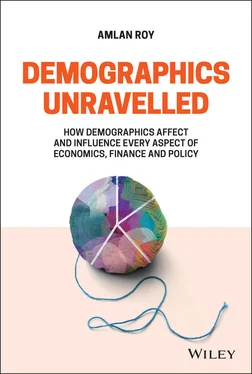The later chapters as outlined in the preface, present data on the ongoing demographic changes, including a historical look back. The focus then is on the implications of those demographic changes on macroeconomic variables such as labour productivity, GDP growth, GDP per capita, inflation, interest rates, and public debt. Further discussion revolves around the effects of demographic changes on asset prices and asset allocation. Individual preferences toward risk and expected return influence the prices of assets. The rise of behavioural finance as a research area helps provide alternate explanations for many observed financial events and data.
A very important applied area of demographics is pensions and insurance. Increased life expectancy has resulted in uncertainties associated with living longer, given limited resources. Individuals want insurance for longer lives and also want to plan better over their lifetimes, which involves decisions on how much to save and which assets to invest those savings in. Pension funds and insurance companies invest in assets that help defray their liabilities. Strategic asset allocation and asset liability management are growing areas of emphasis for institutions that help manage liability risk for individuals. Later chapters of this book also focus on the importance of health from an individual and aggregate perspective, underscoring the importance of healthy life expectancy for society. Demographic changes have effects on inequality across generations, gender, age groups, regions, and countries. We discuss implications for inequality, human development, human capital, sustainability and public governance in later chapters, too.
People influence social change and social policies. Their behaviour is conditioned by the environment that they live in and their past experiences. The environment is determined by the interaction of various systems (health, education, labour, social welfare, legal, political, etc.) and the institutional framework. Policies have a role to play, and the role of government thereby influences the environment within which consumers and workers reside. The potentially negative implications of ageing populations have been characterised by the popular rhetoric of “the demographics time bomb”, posing a threat to ageing developed countries, and several experts, including Peter Peterson, have warned of this 12 , 13 .
In my first research foray into the area of demographics, “The Demographic Manifesto” 14 , we advocated radical policy measures as part of a policy agenda for ageing countries to adopt in order to mitigate the demographic time bomb. In later policy research, I emphasised the need for coordinated and holistic policy across individuals, companies, governments, and international policy institutions to solve this complex issue of ageing, as it has manifold direct and indirect implications.
Changes in consumers and workers pertain to their changing preferences and behaviour as the environment around them changes. Endogenous changes in behaviour reflect the psychology of individuals, which differs across people irrespective of age, gender, or race; it is conditioned on a complex of experiences, environment, and background. Drucker highlights the role of the knowledge worker in a modern, evolving society and the role of information. The role of heterogeneity and diversity in decision-making in response to the changing opportunity set is reflected in the resultant outcomes and outputs.
The focus of demographics is people; and as people “live longer and live differently” than ever before, for the first time in humanity, four to five generations of a family co-exist with hardly one or one-and-a-half generations working to support them. The pressures of supporting multiple generations of members are apparent not just to families but also to governments. Many experts have characterised this ongoing phenomenon as a generational storm 15 or source of potential generational conflict, with the smaller, younger population group having to support a growing old-aged group. The basic question facing societies and countries as they age is one related to finances to support the ageing, as articulated very provocatively and directly by Peter Heller (2003), highlighting the urgency of planning 16 for such a future. Unprecedented demographic changes are heralding challenges and opportunities for society, industry, and governments on the path toward ensuring a profitable, sustainable, and equitable future for the population, which includes all consumers and workers. Therefore, demographics has international, intertemporal, and intergenerational effects across countries and the world.
In the next chapter of this book, I present data on core demographics, looking back and placing the current period in a historical context. I then use the data on population projections from the United Nations (UN), one of the best and most reliable sources of data both across time and countries. The UN population projections are used globally by public and private sector researchers to analyse and understand future data on populations. I refer to these as core demographics data , which are the lifeblood of any demographics-based analysis. The UN databases cover all the consumers in the world, as any individual in the population, whether a baby or a centenarian, is a consumer. For data on workers, I rely primarily on International Labour Organization (ILO) data. In addition to the ILO and UN, data and research reports from the World Bank, International Monetary Fund (IMF), European Commission (EC), Organisation for Economic Cooperation and Development (OECD), Bank for International Settlements (BIS), Groningen Growth and Development Centre (GGDC), US Federal Reserve, European Central Bank (ECB), and other sources are used as and where appropriate.
1 1. Drucker, P.F. (2000). Management Challenges for the Twenty-first Century. Harper Business.
2 2. Kash, R. (2002). The New Law of Demand and Supply. Currency.
3 3. Life tables produced by actuaries using historical data giving conditional probabilities of an individual aged 35 years today living to be 45 years old, 10 years later.
4 4. Wolf, M. (2005). Why Globalization Works. Yale University Press.
5 5. Kahnemann, D. and Tversky, A. (1974). Judgement under uncertainty: heuristics and biases. Science 185 (4157): 1124–1131.
6 6. Thaler, R. (1974). Quasi Rational Economics. Russell Sage Foundation.
7 7. Thaler, R. (2015). Misbehaving: The Making of Behavioral Economics. Penguin.
8 8. Reid, J. (2018). The history (and future) of inflation. Deutsche Bank Research.
9 9. This is my adaptation of Aldous Huxley's Brave New World. We should aim for a Better New World in consistence with the climate change and environmental, social, and governance (ESG) challenges that all of us face.
10 10. Akerlof, G. and Shiller, R.J. (2009). Animal Spirits. Princeton University Press. The title's extension is telling on this point: Animal Spirits: How Human Psychology Drives the Economy, and Why It Matters for Global Capitalism.
11 11. Penn, M.J. (2007). MicroTrends: The Small Forces Behind Today's Big Changes. Penguin, UK. And Penn, M.J. (2019). MicroTrends Squared. Simon and Schuster. Mark Penn, a political strategist and pollster, documented how these small micro-trends were emerging as major forces to change the world.
12 12. Peterson, P. (1999). Gray Dawn. Crown.
13 13. Peterson, P. (1996). Will America Grow Up Before It Grows Old? Random House.
14 14. Keating, G., Hokenson, R.J. and Roy, A. (2000). The demographic manifesto: new jobs, new people. Credit Suisse Research.
15 15. Kotlikoff, L.J. and Burns, S. (2004). The Coming Generational Storm. MIT Press. The book delves into the potential fiscal issues.
16 16. Heller, P. (2003). Who Will Pay? Coping with Ageing Societies, Climate Change, and Other Long-Term Fiscal Challenges. International Monetary Fund.
Читать дальше












